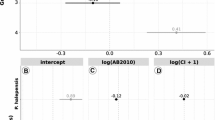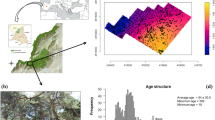Abstract
The intensity of competition between neighboring trees depends on local stand structure, and the influence of stand structure may vary across gradients in soil resource supplies. We used model selection techniques to look for variation in the nature and intensity of interactions between trees along a gradient of soil nitrogen supply in a 9-ha stand of old-growth ponderosa pine (Pinus ponderosa) in Colorado, USA. We used spatially explicit competition indexes to describe the interactions between trees and developed individual tree growth models to look at how soil nitrogen (N) supply affects competition. The growth of focal trees showed an asymmetric influence of neighbors up to 14-m distance. The predictive ability of our growth models more than doubled (to an r 2 = 0.69) as the size of the neighborhood used to calculate the competition indexes increased from a 2-m to a 14-m radius. The supply of soil nitrogen modified competition, with increasing N enhancing competition from neighbors. Neighborhood structure and soil resource supplies jointly influenced the growth of individual trees, but at different scales. Tree interactions are both spatially and temporally complex and may be studied most usefully with explicit evaluation of gradients in resource availability.





Similar content being viewed by others
References
Baribault TW, Kobe RK (2011) Neighbour interactions strengthen with increased soil resources in a northern hardwood forest. J Ecol 99:1358–1372
Begon M (1984) Density and individual fitness: asymmetric competition. In: Shorrocks B (ed) Evolutionary ecology. Blackwell Scientific, Oxford, pp 175–194
Bella IE (1971) A new competition model for individual trees. For Sci 17:364–372
Bertness MD, Callaway R (1994) Positive interactions in communities. Trends Ecol Evol 9:191–193
Beyer F, Hertel D, Jung K, Fender AC, Leuschner C (2013) Competition effects on fine root survival of Fagus sylvatica and Fraxinus excelsior. For Ecol Manage 302:14–22
Binkley D, Hart SC (1989) The components of nitrogen availability assessments in forest soils. Adv Soil Sci 10:57–112
Binkley D, Laclau JP, Sterba H (2013a) Why one tree grows faster than another: patterns of light use and light use efficiency at the scale of individual trees and stands. For Ecol Manage 288:1–4
Binkley D, Campoe OC, Gsalptl M, Forrester D (2013b) Light absorption and use efficiency in forests: why patterns differ for trees and stands. For Ecol Manage 288:5–13
Boyden S, Binkley D, Senock R (2005a) Competition and facilitation between Eucalyptus and nitrogen-fixing Falcataria in relation to soil fertility. Ecology 86:992–1001
Boyden S, Binkley D, Shepperd W (2005b) Spatial and temporal patterns in structure, regeneration, and mortality of an old-growth ponderosa pine forest in the Colorado Front Range. For Ecol Manage 219:43–55
Burkhart HE, Tomé M (2012) Modeling forest trees and stands. Springer, Berlin
Burnham KP, Anderson DR (1998) Model selection and inference: a practical information-theoretic approach. Springer, New York
Canham CD, LePage PT, Coates KD (2004) A neighborhood analysis of canopy tree competition: effects of shading versus crowding. Can J For Res 34:778–787
Coates KD, Lilles EB, Astrup R (2013) Competitive interactions across a soil fertility gradient in a multispecies forest. J Ecol 101:806–818
Coomes DA, Grubb PJ (2000) Impacts of root competition in forests and woodlands: a theoretical framework and review of experiments. Ecol Mon 70:171–207
Diggle PJ (1978) Parameter-estimation for spatial point processes. J R Stat Soc Ser B-Method 40:178–181
Edminster CB, Beeson RT, Metcalf GE (1980) Volume tables and point-sampling factors for ponderosa pine in the Front Range of Colorado. USDA Forest Service Research Paper RM-218, 1–14. Fort Collins
Gholz HL, Grier CC, Campbell AG, Brown AT (1979) Equations for estimating biomass and leaf area of plants in the Pacific Northwest. Research Paper 41, Forest Research Lab, Oregon State University, Corvallis
Goldberg DE (1987) Neighborhood competition in an old-field plant community. Ecology 68:1211–1223
Goldberg D, Novoplansky A (1997) On the relative importance of competition in unproductive environments. J Ecol 85:409–418
Grime JP (1973) Competitive exclusion in herbaceous vegetation. Nature 242:344–347
Grime JP (1979) Plant strategies and vegetation processes. Wiley, Chichester
Harper JL (1977) Population biology of plants. Academic Press, London
Holliday R (1960) Plant population and crop yield. Nature 186:22–24
Hubbell SP, Ahumada JA, Condit R, Foster RB (2001) Local neighborhood effects on long-term survival of individual trees in a neotropical forest. Ecol Res 16:859–875
Landsberg JJ (2003) Physiology in forest models: history and the future. For Biom Model Inf Sci 1:49–63
Montieth JL (1977) Climate and the efficiency of crop production in Britain. Phil Trans R Soc B 281:277–294
Moore R (1992). Soil survey of Pike National Forest, eastern part, Colorado, parts of Douglas, El Paso, Jefferson and Teller counties. United States Department of Agriculture, Forest Service and Soil Conservation Service
Newman EI (1973) Competition and diversity in herbaceous vegetation. Nature 244:310
Oliver WW, Ryker RA (1990) Pinus ponderosa Dougl. ex Laws., ponderosa pine, Pinaceae, Pine family. Silvics of North America, Vol. Agriculture handbook (United States Department of Agriculture); 654., pp. 413-423. U.S. Department of Agriculture, Forest Service, Washington, D.C
Parker G (1930) Scrapbook pertaining to the history of the Colorado School of Forestry. Unpublished manuscript on file at the Tutt Library Special Collections, Colorado College, Colorado Springs, CO
Pretzsch H (2010) Forest dynamics, growth and yield: from measurement to model. Springer, Berlin
Reader RJ, Best BJ (1989) Variation in competition along an environmental gradient- Hieracium floribundum in an abandoned pasture. J Ecol 77:673–684
SAS Institute (2002) SAS statistical software. Version 9. SAS Institute, Cary
Schwinning S, Weiner J (1998) Mechanisms determining the degree of size asymmetry in competition among plants. Oecologia 113:447–455
Silander JA, Pacala SW (1985) Neighborhood predictors of plant performance. Oecologia 66:256–263
Stoll P, Weiner J, Schmid B (1994) Growth variation in a naturally established population of Pinus sylvestris. Ecology 75:660–670
Ter-Mikaelian MT, Korzukhin MD (1997) Biomass equations for sixty-five North American tree species. For Ecol Manage 97:1–24
Tilman D (1988) Plant strategies and the dynamics and structure of plant communities. Princeton University Press, Princeton
Tisdale SL, Nelson WL, Beaton JD (1985) Soil fertility and fertilizers, 4th edn. Macmillan, New York
Trinder CJ, Brooker RW, Davidson H, Robinson D (2012) A new hammer to crack an old nut: interspecific competitive resource capture by plants is regulated by nutrient supply, not climate. PLoS One 7(1): e29413. doi:10.1371/journal.pone.0029413
Uriarte M, Canham CD, Thompson J, Zimmerman J (2004a) A neighborhood analysis of tree growth and survival in a hurricane-driven tropical forest. Ecol Mon 74:591–614
Uriarte M, Condit R, Canham CD, Hubbell SP (2004b) A spatially explicit model of sapling growth in a tropical forest: Does the identity of neighbors matter? J Ecol 92:348–360
Wagner RG, Radosevich SR (1998) Neighborhood approach for quantifying interspecific competition in coastal Oregon forests. Ecol Appl 8:779–794
Waring RH (1983) Estimating forest growth and efficiency in relation to canopy leaf area. Adv Ecol Res 13:327–354
Weiner J (1982) A neighborhood model of annual-plant interference. Ecology 63:1237–1241
Weiner J (1984) Neighbourhood interference amongst Pinus rigida individuals. J Ecol 72:183–195
Weiner J, Thomas SC (1986) Size variability and competition in plant monocultures. Oikos 47:211–222
Weiner J, Mallory EB, Kennedy C (1990) Growth and variability in crowded and uncrowded populations of dwarf marigolds (Tagetes patula). Ann Bot 65:513–524
White J, Harper JL (1970) Correlated changes in plant size and number in plant populations. J Ecol 58:467–485
Wilson JB (1988) The effect of initial advantage on the course of plant competition. Oikos 51:19–24
Wilson SD, Tilman D (1993) Plant competition and resource availability in response to disturbance and fertilization. Ecology 74:599–611
Yoda K, Kira T, Hozumi K (1957) Intraspecific competition among higher plants. IX. Further analysis of the competitive interaction between adjacent individuals. J. Inst Polyt 8:161–178
Acknowledgments
We thank the USDA Forest Service Rocky Mountain Research Station for the use of tree data and for sustaining the research site and infrastructure of the Manitou Experimental Forest. For field and laboratory assistance special thanks goes to Chris Howard. Funding was provided by The Program for Interdisciplinary Mathematics, Statistics and Ecology (PRIMES), and McIntire–Stennis appropriations to Colorado State University. Dan Binkley was supported in part by a Wallenberg Professorship from the Royal Academy of Forestry and Agriculture and the Swedish University of Agricultural Sciences.
Author information
Authors and Affiliations
Corresponding author
Additional information
Handling editor: Aaron R. Weiskittel.
Rights and permissions
About this article
Cite this article
Boyden, S., Binkley, D. The effects of soil fertility and scale on competition in ponderosa pine. Eur J Forest Res 135, 153–160 (2016). https://doi.org/10.1007/s10342-015-0926-7
Received:
Revised:
Accepted:
Published:
Issue Date:
DOI: https://doi.org/10.1007/s10342-015-0926-7




